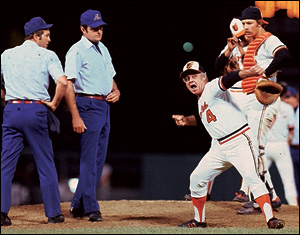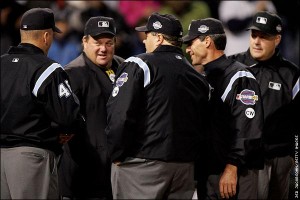By Jake McCormick
Everybody is looking to play off an advantage over their opponent, and that typically manifests into pitching and hitting scouting reports in the MLB. But a few teams have started using those same tactics to beat their other opponent on the field.
Making note of an opponent’s pitcher and hitter tendencies is as common in an MLB clubhouse as pine tar, a deck of cards, and jock straps. It (sometimes) gives a team a competitive advantage by pointing out exploitable flaws in a pitcher or hitter. Now some teams have taken to building a third kind of scouting report…on umpires.Consider this excerpt from a recent AP article on the subject:
Here’s how one team assessed Hunter Wendelstedt: “Inconsistent zone, both in-game and from game-to-game, seemingly losing focus at times by balling pitches over middle and calling strikes on pitches well off plate. Seems to want hitter to put ball in play.”
Or this look at Gerry Davis: “Hesitates to punch hitters out. Towards the top of the league in umpire ERA in 2009, with low K and low BB rate in 2009 and has continued in 2010. Need to earn strikes with him behind the plate.”
In other words, the report says Davis is reluctant to call strike three when a batter doesn’t swing.

(OK that last quote was unnecessarily included in the hopes that a Milwaukee Brewer/Wisconsin Badger fan takes it upon him/herself to try and butter up Foster with football talk before his next game at Miller Park. This can’t be the first time someone has thought of that. Why else would that seemingly irrelevant factoid make it in a scouting report?)
Later on in the article, members of the Washington Nationals, Milwaukee Brewers, and Florida Marlins admit they have never heard of scouting an umpire’s tendencies, but generally agreed it could be somewhat useful. Considering umpires hold the most subjective power out of any sports referees, that’s a mild understatement.
The strike zone is the largest officiating grey area in sports. An umpire’s personal judgment is entrusted with providing an accurate and fair interpretation of strike zone dimensions. If the majority of teams begin compiling reports on each umpire’s preferences, it could very easily lead to a more consistent and universal zone.
Umpire scouting reports not only give teams the advantage of knowing an umpire’s strengths and weaknesses, it also has the potential to hold umpires accountable for perceived personal slights, and inconsistent or “unfair” strike zones. Checks and balances are never a bad thing, especially in baseball, where an umpire’s preferences can legitimately change a team’s approach on the mound or at bat.
Umpire subjectivity with balls and strikes has been a problematic issue in baseball for a long time, and although instant replay is slowly seeping its way onto the diamond, it’s impractical to apply the method of call correction to balls and strikes. If umpire scouting takes off among MLB teams, one of baseball’s hardest problems to fix could be remedied without threatening the flow of the game.
